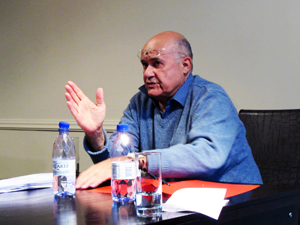Honouring Stanley Trapido – one of the most influential historians South Africa has produced
 Prof Charles van Onselen
Photo: Supplied |
The International Studies Group and the History Department at the UFS hosted a seminar on Stanley Trapido by Prof Charles van Onselen on Monday 11 August 2014.
The seminar honoured the life and work of Trapido, one of the most important and influential historians South Africa has ever produced.
Trapido is probably best known for his work on the causes and consequences of the South African War of 1899–1902. It was to this broad time period that Prof Van Onselen spoke in his paper ‘The Political Economy of the South African Republic, 1881–1895’.
Prof Van Onselen’s lecture provided a major reinterpretation of the origins and causes of the Jameson Raid while emphasising that Paul Kruger’s ZAR was a state beset by crime and corruption. It was particularly fitting that Prof Van Onselen gave the inaugural seminar paper, since Trapido supervised his Oxford doctoral thesis.
The International Studies Group and the History Department were extremely honoured by Trapido’s widow, the Booker Prize nominated author Barbara, attending the seminar. They wish to thank her for donating her husband’s academic library to the UFS.
Following the Sharpeville massacre of 1960, the Trapido-couple emigrated to England. While there, Trapido began to shape what is now known as the ‘revisionist’ school of South African historiography. He argued the importance of analysing capital and class formation, which he maintained informed the racial ideologies that culminated in apartheid.
Prof Van Onselen’s inaugural seminar presentation will be followed later this term by papers from David Moore, Sabelo Ndlovu-Gatsheni and Giacomo Macola.